Among the array of options available for file transfer, Wi-Fi file transfer stands out as a versatile and efficient solution. This article will delve into the realms of Wi-Fi file transfer for PC, exploring its applications from PC to PC, and facilitating transfers between PCs and mobile devices. Join us on this exploration of the wireless world of file sharing. Even if you want to transfer myriads of files on your PC, you can make it much easier than before.
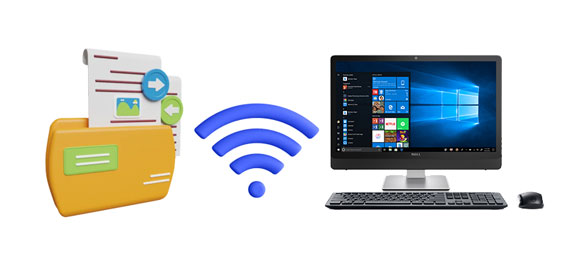
Wi-Fi file transfer refers to the process of exchanging files between devices using a wireless local network, commonly known as Wi-Fi. This method allows users to share various types of files, such as documents, photos, videos, and more, without the need for physical cables or external storage devices.
Wi-Fi file transfer can occur between devices connected to the same Wi-Fi network or through direct device-to-device connections. It provides a convenient and efficient means of sharing data, making it popular for tasks like transferring files between computers, smartphones, tablets, and other compatible devices within the same network range.
To achieve Wi-Fi transfer from PC to PC is not a big deal, but it's important to choose a suitable wireless transfer tool. Thus, there are 4 effective methods provided in this part, and you can use them to send files between PCs via Wi-Fi.
One of the built-in features in modern Windows operating systems, Nearby Sharing enables users to send and receive files effortlessly. With a simple setup, users can harness the power of proximity to transfer files at high speeds without the need for external applications.
+ Nearby Sharing is integrated into the Windows operating system, making it a convenient and readily available option for users without the need for additional installations or configurations.
+ Users can quickly access Nearby Sharing settings and initiate file transfers with just a few clicks, making it accessible even for those less tech-savvy.
+ Allows users to transfer files between PCs in close physical proximity.
+ Supports high transfer speeds, ensuring that files are exchanged swiftly.
- The main drawbacks of Nearby Sharing is its exclusivity to Windows devices.
- Relies on both Bluetooth and Wi-Fi for its operation. In scenarios where these connectivity options are disabled or not available, users may face limitations in using Nearby Sharing effectively.
- While Nearby Sharing is efficient for smaller files, it may not be the most suitable option for transferring large files.
Step 1: Make sure both PCs are connected to the same Wi-Fi network. On a Windows 11 PC, please click "Start" > "Settings" > "System" > "Shared experiences" > "Nearby sharing". Then choose who you are able to share: everyone or your own devices.
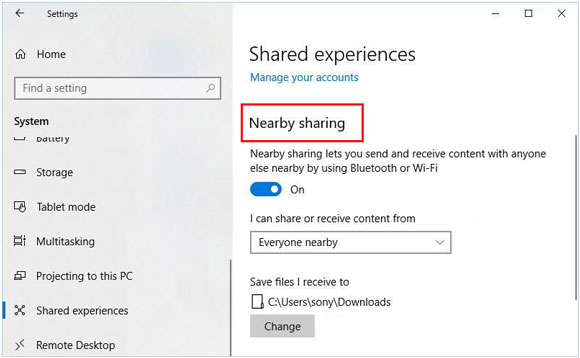
Step 2: Find the file that you plan to transfer, select it, and tap "Share".
Step 3: Select your other computer's name, and then click "Save" on the receiver.
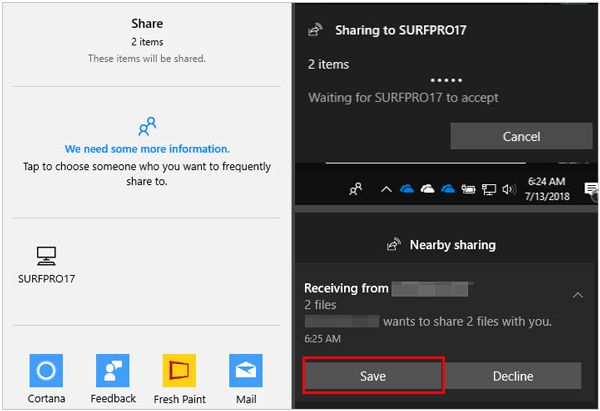
For those accustomed to the familiarity of emails, transferring files via Wi-Fi between PCs becomes a straightforward process. This method proves particularly handy for smaller file sizes and is ideal for users already relying on email communication. In this way, you don't have to connect your PCs to the same Wi-Fi.
+ It's convenient to use the same platform for file transfer.
+ You can access your email from any device with internet connectivity, making it easy to send or receive files from different locations.
+ Email services often integrate with other applications and platforms, allowing for seamless sharing and collaboration.
+ Many email providers use encryption protocols to secure the transmission of emails, providing a level of security for the files being transferred.
- Most email providers impose restrictions on the size of attachments, and larger files may need to be compressed or split into smaller parts.
- Transmitting large files via email can be time-consuming, especially if the internet connection is slow.
- Email accounts often have storage limits, and transferring large files may quickly consume available space.
- Attachments can sometimes get corrupted during the transfer process, leading to issues with the integrity of the files.
Step 1: Open the Mail app on your Windows computer, and then click "Add account" to sign in with your email account. If the Mail app doesn't work, you can browse the Gmail web on your computer and log in with your Gmail address and password.
Step 2: Type your own email address into the receiver blank, and click the "Paperclip" icon to add your desired files.
Step 3: Once done, click "Send". Now, sign in with the same email account on another PC where you want to receive the file. Then open the email from "Inbox", and save the file to this PC.
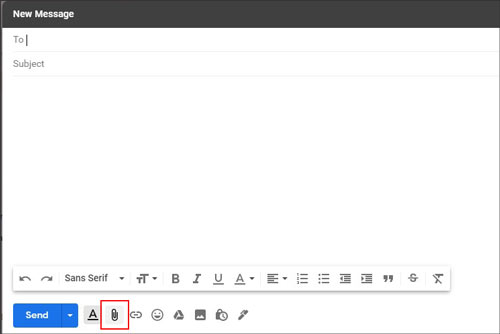
Cloud servers have become integral in the digital landscape, and utilizing them for wireless file transfer for PC adds a layer of accessibility. From Google Drive to OneDrive and Dropbox, this section explores how cloud services simplify file sharing across PCs.
+ Cloud servers provide a convenient way to access your files from anywhere with an internet connection.
+ Cloud services often offer user-friendly interfaces and apps, making it simple for users to upload, download, and manage their files.
+ Provide automatic syncing across devices, ensuring that your files are up-to-date on all connected devices without manual intervention.
+ Files stored in the cloud are generally backed up, reducing the risk of data loss.
- Cloud transfers require a stable and relatively fast internet connection.
- Storing files in the cloud may raise security and privacy concerns, especially if dealing with sensitive or confidential information.
- Free cloud storage plans usually come with limited space.
Step 1: Visit Google Drive on a PC's browser, and log in with your Google account.
Step 2: Click "New" > "File upload" to select the files you want to transfer from your PC. Then they will be stored on Google Drive.
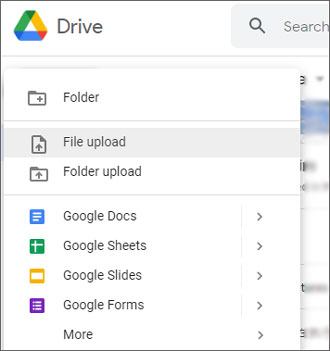
Step 3: Navigate to Google Drive on another PC with the same Google info. Then you will see the uploaded files, click it, and right-click the mouse. Then choose "Download" to store the files to this computer.
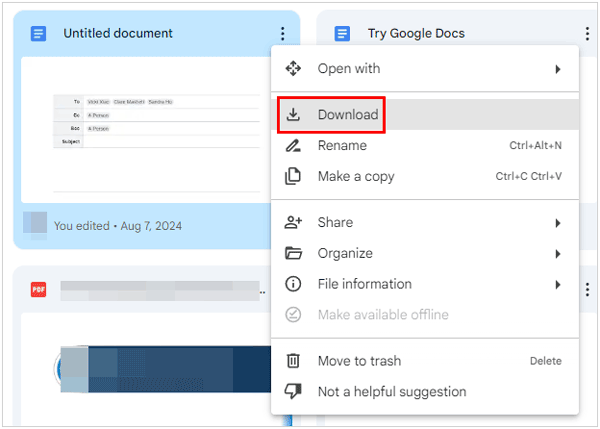
AirDroid steps into the spotlight as a versatile tool for wireless file transfer between PCs. Offering a user-friendly interface and a range of features, AirDroid facilitates seamless data exchange, making it a valuable addition to the Wi-Fi file transfer toolkit.
+ Compatible with multiple platforms, including Windows, macOS, Android, and web browsers, making it versatile and accessible across different devices.
+ Facilitates direct communication between the PC and Android device over Wi-Fi, without relying on an internet connection.
- Transfer speeds may vary depending on the Wi-Fi network conditions, signal strength, and other factors, leading to potential inconsistencies.
- While AirDroid employs encryption for data transmission, users should still exercise caution and ensure that their Wi-Fi network is secure to prevent unauthorized access.
- While a free version of AirDroid is available, some advanced features may require a subscription.
- You cannot send files to yourself directly.
Step 1: Install and launch AirDroid on both PCs, and sign in with two different email accounts.
Step 2: Click "Transfer Files" on the sender, and tap "Friends" > "Add" to enter your other email account. Then hit "Accept" on that PC that you log in with another email account for AirDroid.
Step 3: After that, click the friend to open the conversation. Then click the "File" icon to pick the data you intend to transfer. Finally, click "Send". You will receive the files on your destination computer.
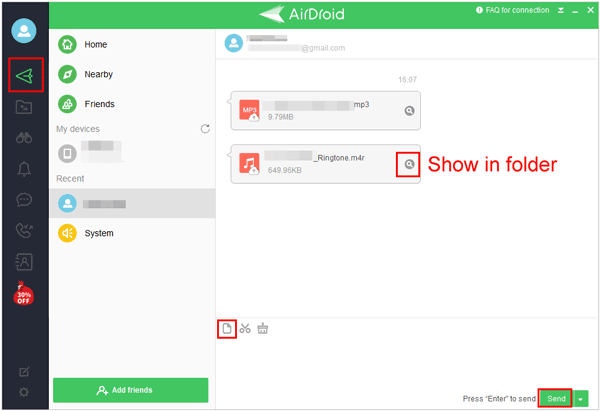
If you want a wireless file transfer from PC to mobile via Wi-Fi, this part will give you a hand. There are 3 efficient approaches that can complete the Wi-Fi file sharing for PC and mobile devices.
This PC to Android file transfer tool - Samsung Messages Backup, is a desktop app to transfer various types of data between Android devices and computers. With it, you can transfer your Android contacts, SMS, photos, videos, apps, and more to a Windows PC or Mac with Wi-Fi. Also, it's easy to import files from a computer to any Android phone and tablet.
+ Selectively transfers files from PC to Android and vice versa via Wi-Fi.
+ USB file transfer between Android and computer is supported and stable.
+ Supports multiple file types, like music, movies, pictures, documents, call logs, and more.
+ No file size limits.
+ Back up and restore Android files in 1 click.
+ Allows you to manage your Android files on a PC or Mac with practical features, such as contact modification, file deletion, app uninstallation, etc.
+ Works for most Android OSes, including Android 14.
+ Supports not only Samsung Galaxy devices but also OnePlus, ZTE, Honor, Google, OPPO, Vivo, Sony, Motorola, etc.
- Requires an identical Wi-Fi network for your PC and Android mobile device.
- Registration is needed to use full features.
Download the transfer tool for the Wi-Fi file transfer between Android and PC.
Step 1: Install and run the transfer program on a computer, and click "Android Assistant" > "Connect via Wi-Fi".
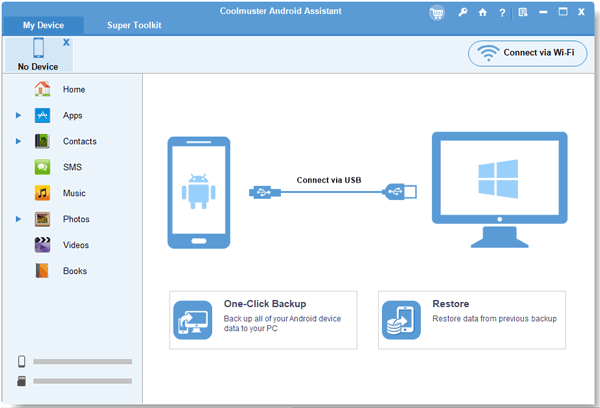
Step 2: Click "Allow access" if prompted, and open the app on your Android device to tap "Scan" to scan the QR code on the PC. Now, your devices are connected.
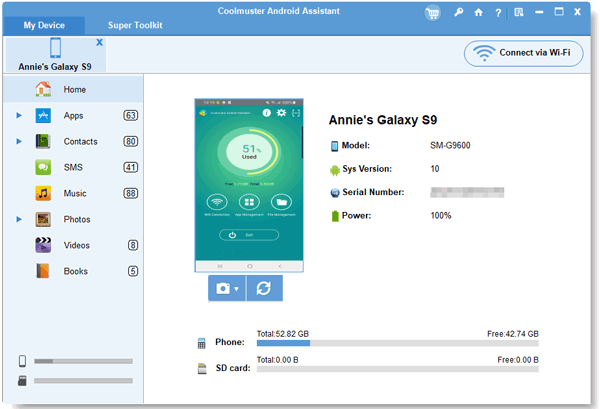
Step 3: Choose a file type on the left panel, and click the "Import" feature to copy the files from your PC to the Android device.
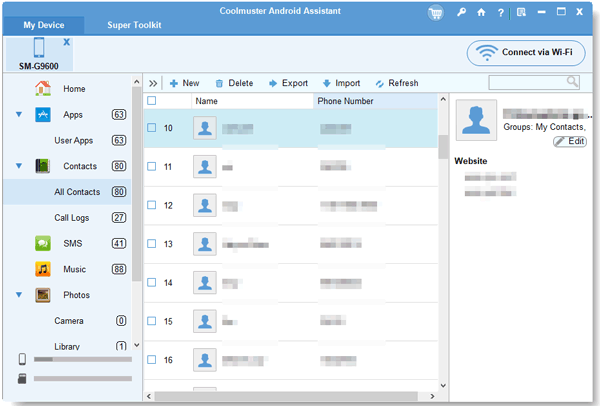
By the way, to export Android files to a computer, you can tap the "Export" icon.
Microsoft's Link to Windows provides an ecosystem where PCs and Android devices harmoniously exchange files. This integrated solution ensures a smooth and secure Wi-Fi file transfer experience.
+ Eliminates the need for physical cables.
+ Setting up Wi-Fi transfer through Link to Windows is typically straightforward.
+ Can be efficient for transferring large files or multiple files simultaneously.
- While Wi-Fi transfer can be fast, it may not match the speed of high-quality USB connections, especially if you are transferring large amounts of data.
- Supports Android 8.0 and upper, having worse compatibility with older Android systems.
- Mac computers are not supported.
- Link to Windows may have occasional bugs or issues that could impact the reliability of Wi-Fi transfer.
Step 1: Download Link to Windows on your PC and Android phone. Then enable Bluetooth on both devices.
Step 2: Launch it, choose "Android" and click "Continue". Then open the app on your phone, and sign in with your Microsoft account.
Step 3: Scan the QR code on the PC to create the connection. After that, drag the files from the PC to the interface. The files will be saved on your Android phone automatically.
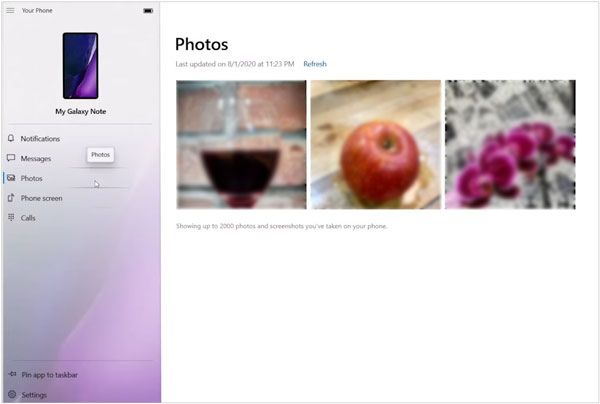
Learn more: 12 File Sharing Apps for Android and iOS and Android to PC (Trustworthy)
SHAREit is a popular file-sharing application that allows users to transfer files, including photos, videos, music, documents, and more, between devices over a Wi-Fi connection. With its user-friendly interface and high-speed transmission capabilities, you can facilitate efficient wireless data exchange.
Pros:
+ Offers a user-friendly interface, making it easy for users to initiate file transfers without a steep learning curve.
+ Supports file transfers between different platforms, such as Windows, Android, iOS, and others.
+ Quickly shares large files without relying on slower traditional methods like USB drives or email attachments.
+ Enables group sharing, allowing multiple devices to connect and share files simultaneously, which can be useful in collaborative settings.
Cons:
- There have been reported security concerns with SHAREit in the past, including vulnerabilities that could potentially be exploited by malicious actors.
- Displays intrusive advertisements within the application. Some users find these ads disruptive and may prefer alternative file-sharing methods without such distractions.
- May compress files during the transfer process to speed up the transfer. While this is done to enhance speed, it can lead to a slight loss in file quality.
Step 1: Install SHAREit on your PC and Android phone. Then launch it.
Step 2: Click "Connect to PC" on Android and scan the QR code to establish the connection between your devices.
Step 3: Click "Send" on the PC, and select the files from the computer, and send to your phone. You will receive the files on the Android device.
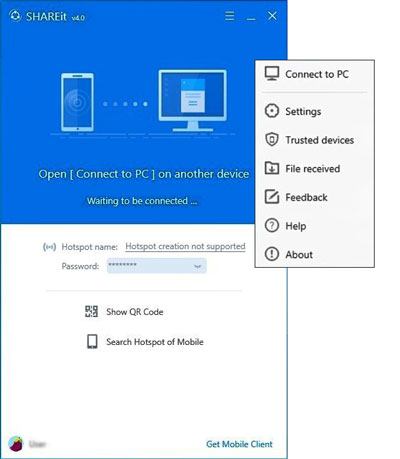
Further reading: Directly View WhatsApp Chat History on PC [Solved]
Q1: Is Wi-Fi file transfer secure?
Security depends on the chosen method and tools. Direct connections may require passwords and encryption for added security. When using a shared Wi-Fi network, it's essential to implement best practices like secure file transfer protocols and network security measures.
Q2: Can I transfer large files over Wi-Fi, and are there any limitations?
Wi-Fi file transfer generally supports large file transfers. However, the speed and success of transferring large files depend on factors such as Wi-Fi signal strength, network congestion, and the capabilities of the devices involved. It's advisable to be mindful of these factors for optimal performance.
Q3: Can I transfer files between different operating systems using Wi-Fi?
Yes, many Wi-Fi file transfer tools are cross-platform and support file transfer between different operating systems, such as Windows, macOS, Android, and iOS. However, it's essential to verify compatibility when choosing a specific tool.
Q4: What does the future hold for Wi-Fi file transfer technology?
The future may bring advancements in Wi-Fi technology, leading to even faster and more efficient file transfers. Integration with emerging technologies, enhanced security features, and improved user interfaces are potential areas for development. Users can expect ongoing improvements in the overall Wi-Fi file transfer experience.
In the realm of modern connectivity, Wi-Fi file transfer for PC emerges as a spotlight of efficiency, liberating users from the constraints of traditional file-sharing methods. Whether it's seamlessly transferring files between PCs or bridging the gap between PCs and mobile device, the methods explored in this article empower users to navigate the digital landscape with ease.
If you'd like a multi-functional file transfer tool for PC and Android, Samsung Messages Backup can meet your needs. This software supports both Wi-Fi and USB transfers. As technology continues to evolve, the realm of Wi-Fi file transfer remains a testament to the pursuit of streamlined connectivity, ensuring that the exchange of data is as swift and convenient as the world we live in.
Related Articles
Control Android from PC Conveniently | 7 Powerful Tools
Expertly Transfer Large Videos from iPhone to PC in 7 Ways (Newest)
How to Connect Android Phone to PC Through Wi-Fi | 5 Reliable Connection Ways
How to Back Up WhatsApp Messages from Android to PC [5 Pragmatic Methods]
How to Recover Deleted Text Messages on Android without PC [Methods & Tips]
How to Transfer Files Between Android Devices via Wi-Fi | 4 Easy Ways
Copyright © samsung-messages-backup.com All Rights Reserved.